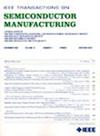Enhancing Current Gain in Polysilicon Emitter Bipolar Transistors Through Emitter-Base Interface Engineering
IF 2.3
3区 工程技术
Q2 ENGINEERING, ELECTRICAL & ELECTRONIC
引用次数: 0
Abstract
Polysilicon is extensively employed as a material for emitters in vertical bipolar junction transistors (BJTs) to achieve high current gain (beta). To enhance the electrical properties of polysilicon emitter BJTs, meticulous engineering of the interface between the emitter polysilicon and the base is crucial. This paper begins by elucidating the sources and implications of variations in interface oxide thickness observed in polysilicon emitter PNP transistors. The deposition of the polysilicon emitter is performed using the low-pressure chemical vapor deposition (LPCVD) furnace process. The formation of native oxide during the LPCVD furnace loading results in significant discrepancies in current gain across different positions within the furnace boat. To understand the underlying mechanisms, we employ thickness measurements through ellipsometry, transmission electron microscopy (TEM) grain analysis, and electrical characterization. To mitigate these variations, several experimental approaches have been pursued. This paper reports that the application of a thin layer of chemical oxide at the interface—achieved through an HF-first RCA clean prior to polysilicon deposition—can establish a controllable, repeatable, and uniform layer of interface oxide. This consistent chemical oxide effectively passivates the silicon surface, leading to stable and uniform electrical performance across all furnace boat positions, thus eliminating variations attributed to furnace loading and waiting times. The proposed solution significantly improves furnace utilization, yield, process capability indices (Cp and Cpk), while also reducing associated costs. Furthermore, this paper introduces an innovative method to modify the emitter-base interface utilizing plasma surface treatment, aimed at enhancing the average current gain performance across all boat positions without compromising breakdown and leakage characteristics. The plasma treatment, which incorporates the application of bias power, induces surface roughness that inhibits the epitaxial realignment of the emitter polysilicon, thereby improving current gain.利用发射基界面工程提高多晶硅发射极双极晶体管的电流增益
多晶硅被广泛用作垂直双极结晶体管(BJTs)的发射材料,以获得高电流增益(beta)。为了提高多晶硅发射极bjt的电学性能,对发射极多晶硅与基底之间的界面进行细致的工程设计是至关重要的。本文首先阐述了在多晶硅发射极PNP晶体管中观察到的界面氧化物厚度变化的来源和含义。多晶硅发射极的沉积采用低压化学气相沉积(LPCVD)炉工艺进行。在LPCVD炉加载过程中,天然氧化物的形成导致炉船内不同位置的电流增益显著差异。为了了解潜在的机制,我们通过椭偏测量、透射电子显微镜(TEM)晶粒分析和电特性来测量厚度。为了减轻这些变化,已经采取了几种实验方法。这篇论文报道了在界面上应用一层薄薄的化学氧化物——在多晶硅沉积之前通过HF-first RCA清洁——可以建立一个可控的、可重复的、均匀的界面氧化物层。这种一致的化学氧化物有效地钝化了硅表面,从而在所有炉船位置上保持稳定和均匀的电气性能,从而消除了由于炉负载和等待时间造成的变化。提出的解决方案显著提高了炉利用率、产量、工艺能力指数(Cp和Cpk),同时还降低了相关成本。此外,本文介绍了一种利用等离子体表面处理来修改发射器-基座接口的创新方法,旨在提高所有船位的平均电流增益性能,同时不影响击穿和泄漏特性。等离子体处理,其结合了偏置功率的应用,诱导表面粗糙度,抑制发射极多晶硅的外延重新排列,从而提高电流增益。
本文章由计算机程序翻译,如有差异,请以英文原文为准。
求助全文
约1分钟内获得全文
求助全文
来源期刊

IEEE Transactions on Semiconductor Manufacturing
工程技术-工程:电子与电气
CiteScore
5.20
自引率
11.10%
发文量
101
审稿时长
3.3 months
期刊介绍:
The IEEE Transactions on Semiconductor Manufacturing addresses the challenging problems of manufacturing complex microelectronic components, especially very large scale integrated circuits (VLSI). Manufacturing these products requires precision micropatterning, precise control of materials properties, ultraclean work environments, and complex interactions of chemical, physical, electrical and mechanical processes.
 求助内容:
求助内容: 应助结果提醒方式:
应助结果提醒方式:


